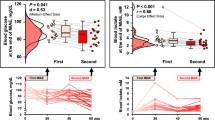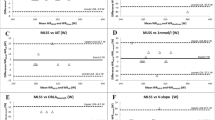Abstract
The lactate threshold (LT) is commonly reported as not different between sexes, yet lower blood lactate concentrations have been reported in women during submaximal exercise. The purpose of the present study was to measure the changes in plasma lactate concentration [La−1] in men and women during incremental cycle ergometer exercise using the same protocol and compare the data using several different methods of analysis. A group of untrained men (n = 21) and women (n = 22) were studied and venous blood drawn at regular intervals during and after exercise for assay of plasma [La−1]. Plasma [La−1] increased during exercise in both sexes, reaching higher values in men, both at exhaustion (men 8.6 ± 2.3 mmol l−1; women 6.2 ± 2.3 mmol l−1; P = 0.01) and post-exercise (men 11.8 ± 2.1 mmol l−1; women 10.2 ± 2.4 mmol l−1; P = 0.03). Logarithmic transformation of the data yielded LT values that were not different between sexes (men 44.2 ± 12.9; women 50.2 ± 12.6; \(\%\dot{V}\hbox{O}_{2{\rm peak}}; P = 0.45\)), yet both the 2 and 4 mmol l−1 fixed concentration LT occurred at lower relative intensities in men (2 mmol l−1: men 50.9 ± 12.9; women 66.9 ± 11.1; \(\%\dot{V}\hbox{O}_{2{\rm peak}}; P = 0.01.\) 4 mmol l−1: men 75.7 ± 11.0; women 90.6 ± 9.2; \(\dot{V}\hbox{O}_{2{\rm peak}}; P = 0.01\)). However, when the plasma [La−1] was examined in both sexes throughout exercise, using a single exponential function, plasma [La−1] was significantly lower in women (P < 0.05) at all relative intensities between 30 and \(100\%\dot{V}\hbox{O}_{2{\rm peak}}.\) While the basis of this sex difference is unknown, reduced plasma [La−1] during submaximal exercise in women may offset to some degree the endurance performance disadvantage of their lower \(\dot{V}\hbox{O}_{2{\rm peak}}.\)

Similar content being viewed by others
References
American College of Sports Medicine (2006) Physical fitness testing and interpretation. In: Whaley MH (ed) ACSM’s guidelines for exercise testing and prescription. Lippincott, Williams and Wilkins, Philadelphia, p 79
Beaver WL, Wasserman K, Whipp BJ (1985) Improved detection of lactate threshold during exercise using a log–log transformation. J Appl Physiol 59:1936–1940
Bhambhani Y, Maikala R (2000) Gender differences during treadmill walking with graded loads: biochemical and physiological comparisons. Eur J Appl Physiol 81:75–83
Carter SL, Rennie C, Tarnopolsky MA (2001) Substrate utilisation during endurance exercise in men and women after endurance training. Am J Physiol Endocrinol Metab 280:E898–907
Charkoudian N, Joyner MJ (2004) Physiologic considerations for exercise performance in women. Clin Chest Med 25:247–255
Coyle EF, Martin III WH, Bloomfield SA, Lowry OH, Holloszy JO (1985) Effects of detraining on responses to submaximal exercise. J Appl Physiol 59:853–859
Coyle EF, Coggan AR, Hopper MK, Walters TJ (1988) Determinants of endurance in well trained cyclists. J Appl Physiol 64:2622–2630
Deschenes MR, Hillard MN, Wilson JA, Dubina MI, Eason MK (2006) Effects of gender on physiological responses during submaximal exercise and recovery. Med Sci Sports Exerc 38:1304–1310
Esbjörnsson M, Sylven C, Holm I, Jansson E (1993) Fast twitch fibres may predict anaerobic performance in both females and males. Int J Sports Med 14:257–263
Gladden LB (1989) Lactate uptake by skeletal muscle. Ex Sports Sci Rev 17:115–155
Green HJ, Fraser IG, Ranney DA (1984) Male and female differences in enzyme activities of energy metabolism in vastus lateralis muscle. J Neurol Sci 65:323–331
Habedank D, Reindl I, Vietzke G, Bauer U, Sperfeld A, Gläser S, Wernecke KD, Kleber FX (1998) Ventilatory efficiency and exercise tolerance in 101 healthy volunteers. Eur J Appl Physiol 77:421–426
Heck H, Mader A, Hess G, Mucke S, Muller R, Hollmann W (1985) Justification of the 4 mmol/l lactate threshold. Int J Sports Med 6:117–130
Helgerud J (1994) Maximal oxygen uptake, anaerobic threshold and running economy in women and men with similar performance levels in marathons. Eur J Appl Physiol 68:155–161
Horton TJ, Pagliassotti MJ, Hobbs K, Hill JD (1998) Fuel metabolism in men and women during and after long-duration exercise. J Appl Physiol 85:1823–1832
Howley ET, Bassett DR, Welch HG (1995) Criteria for maximal oxygen uptake: review and commentary. Med Sci Sports Exerc 27:1292–1301
Hughson RL, Weisiger KH, Swanson GD (1987) Blood lactate concentration increases as a continuous function in progressive exercise. J Appl Physiol 62:1975–1981
Kindermann W, Simon G, Keul J (1979) The significance of the aerobic–anaerobic transition for the determination of work load intensities during endurance training. Eur J Appl Physiol 42:25–34
McMorris T, Sproule J, Draper S, Child R, Sexsmith JR, David Foster C, Pattison J (2000) The measurement of plasma catecholamine and lactate thresholds: a comparison of methods. Eur J Appl Physiol 82:262–267
Myers J, Walsh D, Buchanan N, McAuley P, Bowes E, Froelicher V (1994) Increase in blood lactate during ramp exercise: comparison of continuous and threshold models. Med Sci Sports Exerc 26:1413–1419
Newsholme EA, Leech AR (1983) Biochemistry for the medical sciences. John Wiley and Sons, Chichester, UK
Phillips SM, Atkinson SA, Tarnopolsky MA, MacDougall JD (1993) Gender differences in leucine kinetics and nitrogen balance in endurance athletes. J Appl Physiol 75:2134–2141
Rowell LB (1993) Human cardiovascular control. Oxford University Press Inc., New York
Ruby BC, Coggan AR, Zoleric TW (2002) Gender differences in glucose kinetics and substrate oxidation during exercise near the lactate threshold. J Appl Physiol 92:1125–1132
Shephard RJ (2000) Exercise and training in women, part 1: influence of gender on exercise and training responses. Can J Appl Physiol 25:19–34
Simoneau JA, Lortie G, Boulay MR, Thibault MC, Theriault G, Bouchard C. (1985) Skeletal muscle histochemical and biochemical characteristics in sedentary male and female subjects. Can J Physiol Pharmacol 63:30–35
Speechly DP, Taylor SR, Rogers GG (1996) Differences in ultra-endurance exercise in performance-matched male and female runners. Med Sci Sports Exerc 28:359–365
Tarnopolsky LJ, MacDougall JD, Atkinson SA, Tarnopolsky MA, Sutton JR (1990) Gender differences in substrate for endurance exercise. J Appl Physiol 68:302–308
Tarnopolsky MA, Atkinson SA, Phillips SM, MacDougall JD (1995) Carbohydrate loading and metabolism during exercise in men and women. J Appl Physiol 78:1360–1368
Wideman L, Weltman JY, Shah N, Story S, Veldhuis JD, Weltman A (1999) Effects of gender on exercise-induced growth hormone release. J Appl Physiol 87: 1154–1162
Author information
Authors and Affiliations
Corresponding author
Rights and permissions
About this article
Cite this article
Sargent, C., Scroop, G.C. Plasma lactate accumulation is reduced during incremental exercise in untrained women compared with untrained men. Eur J Appl Physiol 101, 91–96 (2007). https://doi.org/10.1007/s00421-007-0477-9
Accepted:
Published:
Issue Date:
DOI: https://doi.org/10.1007/s00421-007-0477-9




